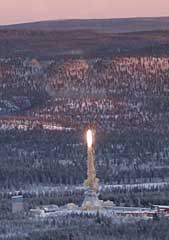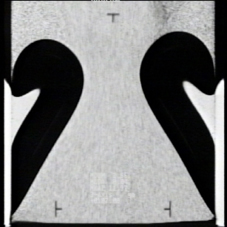CCF on TEXUS 41
a sounding rocket experiment on capillary channel flow

On Dec. 2, at 10:30 UTC, the sounding rocket TEXUS 41 was launched from ESRANGE in Kiruna, Sweden. The rocket reached an altitude of 230 km and provided 5 minutes and 28 seconds of compensated gravity with an acceleration level below 10e-4 of earths gravity. During that time the CCF team performed all experiment operations online via telecommand with two video channels available. Two coarse and one fine approach to the critical flow rate was realized. The free channel length was varied online between 12 mm and 19 mm. The hypothesis that besides a critical flow rate for a given length also a critical length for a given flow rate exists, was proven for the first time. The experiment goals have been achieved with great success.
aims
The aim of the experiment is the investigation of a liquid flow through an open capillary channel. The channel consists of two parallel plates of breath b = 25 mm, leaving a gap of a = 10 mm between them. The channel is filled with liquid and a flow is established by means of an external pump. Free liquid surfaces are formed at the sides and the flow path is maintained by capillary forces. The channel length with a free surface is l = 12 mm, which can be changed during the experiment, as well as the flow rate. A capillary channel of this size filled with a HFE-7500 liquid from 3M is unstable under earths gravity conditions. With residual accelerations less than 10e-4 of earths gravity and an adequate boundary condition the free surfaces bend inwards corresponding to the pressure changes along the flow path. If the internal pressure falls below a certain value, the free surfaces collaps and gas is ingested. The goal is the determination of the critical flow rate up to which a steady flow is achieved in the channel. Furthermore the contour and the velocity at dedicated points are measured. The results are important for fluid management in space and the fundamental fluid mechanics problem of flow rate limitation.
Applications
Technologies for liquid management in space use capillary forces to position and transport liquids, since the hydrostatic pressure is absent which gives the liquid a defined surface and enables easily to withdraw it from the bottom of a tank. But the effect of capillary forces is limited on earth to a few millimeters. In the reduced gravity environment of space these forces can affect free surfaces extended over meters. For the application of open channels in propellant tanks of spacecrafts, the limitations must be known since only bubble free liquid is allowed for the thrusters. From a fluid mechanical point of view a characteristic velocity must exist which cannot be exceeded by any means. To find this velocity and the point of collaps of the free surface, the surface profile must be measured with great accuracy. Furthermore the local flow velocity at dedicated points of the channel must be known.
Experiment procedure
Prior to the launch the capillary channel is empty and the liquid is enclosed in the reservoir by means of slide valves. Earths gravity and the accelerations during the launch would destroy the liquid bridge in the channel. Upon reaching the accepted value of residual accelerations (10e-4 of earths gravity) several valves are opened via telecommand and the free surfaces in the channel as well as a compensation tube are created. A flow rate in the channel well below the critical value is established and the procedure starts. The flow rate is increased in coarse and fine steps. Two video channels are available in real time from the rocket as well as other data from the experiment module. One of the TV channels is recorded onboard in DV quality. The experiment procedure is performed manually controlled from the ground. In addition to the scientific and technological results, this experience is very useful for the design and operation of the space station experiment CCF.
Experiment results
The experiment module worked well, the 2 video channels were recorded on ground and additionally one channel on board. The experiment procedure started automatically at t = + 74 s opening the compensation tube slide valve. A calculated amount of liquid was pushed in the compensation tube via telecommand. After a relaxation time of some seconds the test section slide valve was opened and the capillary channel filled itsself due to capillary forces. When the meniscus reached the closed section of the channel the withdrawal of liquid via the main pump at a subcritical flow rate started. This initialization of the fluid loop was performed without problems.

In the course of the following measuring program two coarse and one fine approach to the critical flow rate were realized. Additionally the free channel length was varied between 12 mm and 19 mm. The hypothesis that besides a critical flow rate for a given length also a critical length for a given flow rate exists, was proven for the first time. The critical values could be identified clearly on the video images (collaps of the free surface) and by the flow meter signal (caused by the gas bubbes). The flow velocity was measured with a miniaturized Laser-Doppler anemometer. The measuring volume was positioned in the middle of the channel at the narrowest part. Parts of the velocity profile could be evaluated by moving the LDA perpendicular to the plates.


 "
"